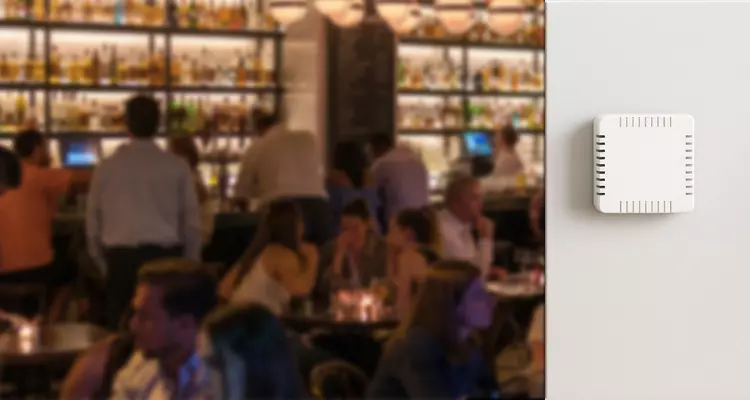Why Monitoring CO2 and Noise in Restaurants Matters: HibouAir’s Solution for Healthier Dining
Modern diners expect more than delicious food and stylish decor – they want to know the environment they eat in is safe and comfortable. Air quality and acoustic comfort are often overlooked in restaurants, yet they shape the experience just as much as the menu. Research by the U.S. Environmental Protection Agency (EPA) shows that indoor air can be two to five times more polluted than outdoor air, and in crowded spaces like restaurants the concentrations of pollutants can be even higher. The World Health Organisation warns that prolonged exposure to indoor pollutants such as fine particles, carbon dioxide (CO2) and volatile organic compounds (VOCs) can lead to asthma, allergies, lung inflammation and other health issues. On the acoustic side, studies by the Acoustical Society of America have found that constant exposure to high noise levels increases stress, makes conversation difficult and can even reduce appetite.
Restaurants face unique challenges. Cooking fumes from grilling and frying release particulate matter and VOCs.Disinfectants and cleaning agents add more VOCs. Crowded dining rooms lead to rising CO2 levels, and furniture and decor can emit chemicals over time. Without monitoring, these pollutants and high noise levels accumulate and directly affect customer comfort, staff well‑being and even food safety perceptions. That is why health‑conscious diners increasingly pay attention to the invisible environment, especially since the COVID‑19 pandemic. Indoor air quality (IAQ) and sound are no longer luxuries – they are essential parts of the dining experience.
Why Restaurants Should Monitor CO2 and Noise
Protecting health and productivity
High CO2 levels indicate poor ventilation. When CO2 rises above about 1,000 ppm, people often report fatigue, headaches and diminished cognitive performance. In a busy restaurant where occupancy fluctuates, CO2 can easily climb into this range. Pollutants such as PM2.5 and VOCs from cooking and cleaning exacerbate respiratory conditions and aggravate allergies. Monitoring CO2 alongside temperature and humidity helps managers ensure ventilation systems are adequate and identify times when fresh‑air intake needs to be increased.
Noise is another invisible stressor. Elevated background noise makes it hard for diners to converse and for staff to concentrate. The Acoustical Society of America notes that constant exposure to high sound levels increases stress, impairs conversation and lowers appetite. For restaurants positioning themselves as calm, family‑friendly or upscale, monitoring decibel levels helps maintain the ambience guests expect.
Meeting customer expectations
The pandemic heightened public awareness of indoor hygiene. Guests now associate a healthy restaurant not just with clean surfaces but also with clean air.Transparent monitoring builds trust: displaying current CO2 or noise levels shows diners that management is proactive. By ensuring that CO2, VOCs and noise stay within recommended limits, restaurants can reduce complaints of discomfort, support staff productivity and reinforce their reputation as health‑conscious establishments.
HibouAir CO2 & Noise Sensor: A Smart Solution for Restaurants
Addressing air quality and acoustic comfort requires reliable data. HibouAir’s CO2 with Noise Sensor device brings that data directly to restaurateurs. Developed by Smart Sensor Devices, this multi‑sensor monitor continuously measures CO2, ambient pressure, temperature, relative humidity, VOCs and noise levels.
How HibouAir Supports Smarter Restaurant Management
Real‑time insights and actionable data
HibouAir’s multi‑sensor platform enables restaurant managers to see live CO2 and noise levels on their phones or desktops and to receive alerts when readings exceed comfort thresholds. Real‑time monitoring means staff can respond quickly—opening windows, adjusting HVAC settings or lowering music volume—before guests notice discomfort. By reviewing historical data, managers can identify patterns, such as elevated CO2 during peak dining hours or increased noise when the bar area is busy, and plan interventions like adding ventilation or acoustic panels.
Enhancing the dining experience
Maintaining healthy air quality and comfortable sound levels improves both staff performance and customer satisfaction. Cleaner air reduces headaches and fatigue, leading to better service and happier diners. Pleasant acoustics allow conversations to flow without shouting. Healthier air leads to better work environments, fewer complaints from guests and stronger brand perception. HibouAir’s device helps restaurants achieve those benefits without disrupting decor or operations.
Building trust and regulatory compliance
Displaying current CO2 and noise readings shows that a restaurant is committed to safety and transparency. As environmental regulations evolve to address indoor air quality, having reliable monitoring equipment will help venues stay ahead of requirements.

Cost‑effective and scalable
With a price point around US $135 and a plug‑and‑play setup, HibouAir offers an affordable entry into environmental monitoring. The device is portable and can be moved between dining areas or installed permanently on a wall mount. Multiple units can connect to the HibouAir cloud dashboard for enterprise‑level management, making it suitable for large restaurant chains as well as independent bistros. The mobile app stores seven days of data, and the desktop and cloud solutions provide longer retention for deeper analysis.
Dining is a multi‑sensory experience. While chefs and designers craft menus and atmospheres, the air and sound within a restaurant quietly shape how guests feel and remember their visit. Research underscores that indoor air quality and noise directly affect health, comfort and business outcomes. HibouAir’s CO2 & Noise Sensor helps restaurants to monitor these invisible factors with precision and ease. By integrating comprehensive environmental sensing with user‑friendly apps, it allows restaurant owners to create healthier, quieter spaces that foster better staff performance and happier, more loyal customers.

